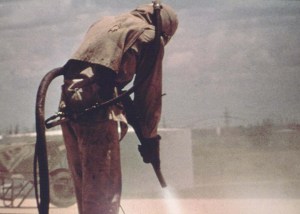
03 Nov Safety Considerations For Sandblasting
Safety Considerations For Sandblasting
 Sandblasting operations can be overlooked when preparing safety plans because they are generally a small part of a larger project such as cleaning and refinishing or painting. As a result, many workers are exposed to the hazards of sandblasting without adequate protection. Even if all sandblasting equipment is properly designed and regularly inspected, users must always be alert to the hazards of these operations and take precautions against harmful exposures.
Sandblasting operations can be overlooked when preparing safety plans because they are generally a small part of a larger project such as cleaning and refinishing or painting. As a result, many workers are exposed to the hazards of sandblasting without adequate protection. Even if all sandblasting equipment is properly designed and regularly inspected, users must always be alert to the hazards of these operations and take precautions against harmful exposures.
Airborne dust: This is one of the most serious hazards associated with blasting operations. When evaluating this hazard, it’s important to consider the concentration of dust and the size of particles. Larger particles, considered “nuisance” dust, are normally filtered out in the nose and throat. Smaller particles (10 microns or smaller) can bypass the lung’s filtering system and penetrate deep into the respiratory system, where they may cause serious damage. Safeguards are needed when smaller particles are present in the working environment.
Metal dust, in addition to the abrasive being used, contributes to the generation of airborne dust. Metals such as lead, cadmium, and manganese, can be extremely toxic when inhaled. Many existing paints have a lead base. Regulations require special handling, trained personnel, and medical monitoring when lead is present. If in doubt, check it out. Don’t guess.
Silica sand: This product is a potentially serious health hazard and should not be used as an abrasive. If silica containing (quartz) materials are selected for any reason, workers must wear a positive pressure or pressure demand respirator with an assigned protection factor (APF) of either 1000 or 2000. Silica must be contained and disposed of properly. Even if a wet blasting method is selected, silica that is allowed to migrate by either wind or water will eventually become an airborne contaminant.
Air supply: Air-supplied respirators must be used (1) when working inside of blast cleaning rooms, (2) when using portable units in areas without an enclosure, and (3) under any circumstances where the operator is not physically separated from the abrasive material by an exhausted enclosure. If airline respirators and compressors are used, make sure the intake hose is placed in an area that provides clean air. An attendant should be in the area at all times, monitoring breathing air and assuring the blaster’s safety.
Additional personal protective equipment: Blasting operations create high noise levels, so hearing protection is a must–for both the operator and nearby workers! Operators should also use heavy canvas or leather gloves, aprons, or leggings when appropriate, as well as safety shoes.
Manual cabinet blast cleaners should never be exhausted into an area where workers can breathe dust. These fully enclosed cabinets are designed to filter out dust and re-use blasting medium.
Handling and storing abrasives: Dust is nearly always created at any point where abrasives are transferred, whether by hand or shovel. Therefore, all points of transfer must be properly exhausted and workers who handle abrasives manually should wear particulate filter respirators.

